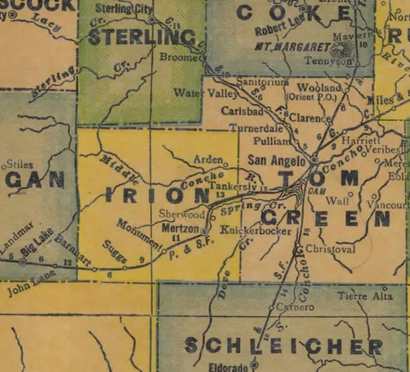Barnhart, Texas and Texas� last major cattle trail. (original) (raw)
| by Mike Cox |  |
|---|
Dust, bawling cattle, hell-raising cowboys and trains a half-mile long � that was Barnhartin the 1920s and �30s.
Once a bustling if miniature version of Fort Worth, this unincorporated Irion County town is mighty quiet these days. The population in 2009 was only 169, and Barnhart�s school closed in 1969. (If you want big city life in these parts, go to the county seat of Mertzon, population 800-plus.)
Barnhart began when the Kansas City, Mexico and Orient railroad cut through West Texas in 1911. The name honored William F. Barnhart, the land agent who obtained the right of way for the company�s tracks west of San Angelo.
Because of the Orient�s location between major rail lines on the north and south, Barnhartquickly became an important shipping point for the vast chunk of real estate in between. Cattleand sheep poured out of West Texas on trains loaded at Barnhart.
The town had everything the cowboys and railroaders needed: A hotel, cafes, a bank and a theater. A weekly newspaper, the Barnhart Range, provided the town with local news.
Given the remoteness of West Texas, old-fashioned trail drives continued to Barnhart long after their heyday elsewhere. In fact, all those cattle coming through began to cause local ranchers problems. To protect their pastures from over-grazing, ranchers started putting up more fences. That ended what may have been one of the last semi-free range holdouts in Texas.
To get around the problem, the Ozona-Barnhart Trap Co. was organized in 1924. A long, narrow swath of leased or purchased land stretching 34 miles from south of Ozonato Barnhart became Texas� last major cattle trail, a corridor one newspaper labeled �the world�s most unusual highway.� Along it acreage for a series of six �traps� or pens � as important to cattle movement in those days as locks are to the Panama Canal � was acquired by the company and fenced to hold traveling livestock.
The company assessed five cents a head each night for cattle kept in one of the traps. Sheep, for one cent a head, could also be kept overnight in the traps. All a trail boss had to do was tell Ted Adkins, the company� Barnhart-based weigher, how many animals had stayed in a trap and pay him for that amount. No paperwork required.
If a sheep shipper needed help getting his animals motivated to board a train, Adkins could furnish two lead goats � Lou and Whitney. Their follow-the-leader services cost 50 cents a carload.
Meanwhile, the railroad constructed large holding pens adjacent to its trackage at Barnhart. With ample infrastructure to serve a rancher�s needs, sometimes as many as three trail drives a day hit town while trains with as many as 75 cattle cars hauled West Texas livestock to distant markets.

1940s Irion and Tom Green County maps showing Barnhart, Mertzonand San Angelo. Courtesy Texas General Land Office
Prosperity brought its problems. In April 1934, the town�s former postmaster pled guilty in federal court to �conversion of funds.� Barnhart, stuck pretty much out in the middle of nowhere, definitely lacked in the law and order department.
At some point in 1934, the town solicited assistance from the brother of one of the state�s best known peace officers, Texas Ranger Capt. Frank Hamer, to pacify its lawless element. That man was Harrison L. Hamer, a former ranger and just about as quick on the trigger as his older, more famous sibling. Frank Hamer had presided over the bloody demise of the outlaw couple Bonnie Parker and Clyde Barrow that May, but brother Harrison had laid low a badman or two himself.
�Harrison is doing quite a bit of cleaning up in our town among the trash,� wrote his sister Alicia Cumbie to their mother on Aug. 20, 1934. �And they sure are getting hostile. This place sure needs someone to clean it up but he is sure up against a tough dirty bunch. He has a bunch of them in jail now.�
The bad guys may have been �a tough dirty bunch,� but Hamer, who apparently only stayed in Barnhart a short time before returning to his home in Del Rio, lived to old age and died of natural causes. Though what Hamer did in Barnhart seems to have generated practically no newspaper coverage, he evidently prevailed in restoring order.
Crime was not Barnhart�s only problem in 1934. While that year the Associated Press declared Barnhartthe busiest livestock shipping point in the nation, not every outbound train held jostling beeves. At the depth of the Depression, the federal government had begun buying cattle and having them shot to reduce supply, hoping to revive a market that had practically dried up. Ranchers got paid on the number of cowhides they shipped out and sheep skinners made good money turning their knives on dead cattle.
The Atchison, Topeka & Santa Fe eventually bought out the Orient, but Barnhartcontinued to flourish as a cow town through the 1940s. The advent of better roads and the widespread use of cattle trucks signaled an end to Barnhart�s era as a major shipping center and 20th century Dodge City.
� Mike Cox
"Texas Tales"
March 24, 2010 column
See Also:
Texas Ranching - Ranching, Cattle Drives, Cowboys and more
Books by Mike Cox - Order Now